LIBERTY WAY aka Rushden by-pass
Since the completion of the Rushden by-pass and the fact that 2005 was the 60th Anniversary commemorating the end of World War II, it was felt by members of the Town Council that naming the by-pass 'Liberty Way' would pay tribute to the 1600 American servicemen who lost their lives flying from Podington and Chelveston, and who had became part of the community. There will also be a memorial plaque erected on the by-pass. The road signs will be dedicated at the United Church Service in the Hall Park on Sunday 10th July.
USAAF BASES
RAF Chelveston was built in 1941, and the American 305th Bombardment Group moved in to the base in September 1942. Known as the "Can Do" Group, they completed 337 missions suffering their heaviest loss on 14th October 1943 raid to Schweinfurt, when they lost 13 B-17's of the 18 taking off from Chelveston. Many times, the aircraft would take off from the airfield in the early hours on their raids over Germany. At the peak of their time at Chelveston, there were as many as 2,894 men stationed there. They were to lose 154 Flying Fortresses during their time at this important base and it is essential that their missions are not forgotten.
RAF Podington was originally built for use as an R.A.F. bomber station, but the main occupants were the American 92nd Bombardment Group who arrived in September 1943. Known as "Fame's Favoured Few" their first mission from Podington was on 23rd September and 308 missions were completed to the end of the war. One of the 92nd Bombardment Groups claim to fame is that they flew the secret Disney rocket bomb experimental missions early in 1945. The Group also lost 154 Flying Fortresses whilst at Podington, with each aircraft having a crew of 10 men. With the same number of personnel at this airfield, the impact of the American involvement in this area on the local population was quite unique!! John N Smith
|
|
Memories taken from the Programme for Party in the Park 2005
|
Lt-Cdr Dennis Copperwheat, GC Edited newspaper articles
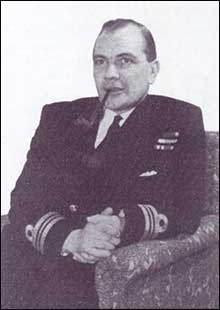 |
|
Dennis Copperwheat
|
On March 24th 1942 the two survivors of a four-ship convoy, dispatched from Alexandria with badly-needed supplies and ammunition for the besieged island of Malta, entered the harbour to the cheers of thousands of Maltese lining the ramparts of Valletta.
Despite ferocious air attacks, in which both ships were hit by bombs, the unloading began. After two days one ship was sunk and the other, the Norwegian cargo liner Talabot, caught fire. Talabot still had hundreds of tons of ammunition on board, and as the fire spread it became clear that a huge explosion was imminent, threatening to flatten much of Valletta and neighbouring Floriana. Copperwheat, who was then torpedo officer of the cruiser Penelope, together with a party of sailors from Penelope and her sister ship Aurora (which was in dry dock in Malta), went on board Talabot to scuttle her.
The intensity of the fires prevented them from placing charges below, so they were lowered over the side to lie against the ship's hull. Talabot was moored some 40 yards offshore, and Copperwheat - who was going to detonate the charges electrically - had only just enough wire to reach the jetty.
His sailors took cover, but Copperwheat himself had to stay in the open while he fired the charges: the explosion blew him into the air and nearly killed him. Much ammunition was later recovered from Talabot, and many of the heavy bombs on board were eventually dropped on the enemy. His wife, Olive, of Park Road, Rushden, said "He wouldn't worry himself -not one atom! I have never known anyone cooler." Copperwheat's George Cross was gazetted on 17th Nov 1942, and he received it from King George VI at Buckingham Palace a week later.
|
|
An R.A.F. Experience - by Don Bass
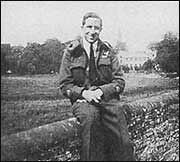 |
|
Don Bass
|
I volunteered for flying duties with the R.A.F in 1941 and did my training as a WOP/AG in Blackpool, the radio school, Yatesbury, the 13 AG. School in Egypt and OTU at Shandur. I became attached to the South Africa Air Force crewed up in the American B26 Glen Martin 'Marauder' in which I flew on operations. I flew to Italy in June 1944 and joined the 30 Sqdra. S.A.A.F. at Pescara, our target area being Central and Northern Italy, Yugoslavia and Austria, and at times gave close support to the 8th Army around the Rimini area and the Gothic Line.
March 14th 1945 - We were briefed to attack marshalling yards at Pontebra on the Austrian/Italian border. At 13,000ft we flew into a snowstorm. Clearing it, our No. 2 was not in position and was spotted beneath us climbing to regain position. There was no time for evasive action and at 240mph, we collided. The Skipper's voice came over "Bale out chaps, and good luck!" I was descending when at 9,000ft I saw No.2 aircraft explode into the side of a mountain. Five of my squadron friends perished. Nearing the ground, my body passed through pine trees, but my chute did not, and I was left hanging 30ft above the ground until releasing my chute, when I fell in to 2ft of snow injuring my right leg. A German patrol with dogs picked me up, took me in for interrogation, then on to No. 21 Krieg Lazarette, Tarvisio, where my leg was encased in plaster for a month. May 6th 1945 - We heard shouts of "The English are here!" and outside I saw a jeep with two Army chaps being an advanced patrol of the Popskis Private Army. Four days later. I flew to a hospital in Naples and in two weeks, boarded the 'Empress of Scotland' homeward bound. I arrived in Liverpool on June 10th, and caught a train to R.A.F. Cosford, only to be greeted by a very smart W/O with the words "Where the hell have you lot been? On a cook's tour!!!" to which one of the P.O.W.'s shouted "We are home chaps, we are home!"
|
|
A Naval Experience by Cliff Jeffries - President Rushden Royal British Legion, President Rushden & District Royal Navy Association
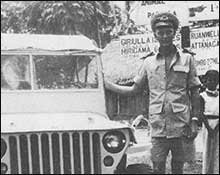 |
|
Cliff Jeffries
|
I was required to take a Trade's test before being accepted as a volunteer into the Engine Room branch of the wartime Royal Navy - one of my first duties, a very minor position, being in the underground Combined Ops CinC HQ in the West of England. A further instruction sent me to join a 'stand by' team in Hall Russell's shipyard, Aberdeen, where a twin screw Corvette was being built. This was later to be launched as H.M.S. Test, one of the first River Class Frigates. I remained with the'Test' as she was designated to an escort group out of Londonderry, escorting convoys in the Battles of the Atlantic and Mediterranean and the North Africa and Sicily Campaigns. During that time H.M.S. Test was attributed one unconfirmed U-Boat sinking, and the confirmed sinking of U-Boat A36 on 26th May 1943. Later we escorted a captured U-Boat to Africa and for the best part of 2 years, I remained on board the 'Test' as we worked with the South African Navy on antisubmarine duty in the South Atlantic and Indian Oceans. I left South Africa and served in Burma and Ceylon, returning eventually to the U.K on a Light Fleet Aircraft Carrier. |
|
Memories by F/Lt. H.W. Catlin, D.F.C., B.A
Sixty years on - many are my memories associated with the end of the European hostilities. First and foremost was the extreme relief of not having to face the trauma of the German anti-aircraft defences night after night; also, not having to suppress one's fear and appear completely nerveless and unafraid. According to Bomber Command statistics I ought not to be around to witness this victory, indeed I was one of the lucky ones.
Nowadays I often recall one of those silly things - my Mid Upper Gunner would always call out reassuringly over the intercom, when we had crossed the enemy coast and were in comparative safety approaching the English coast, "well done chaps we've beaten the old b...s again!!"
Sixty years ago we had - unfortunately at a dreadful cost.
|
The Bevin Boys by Dennis Hill
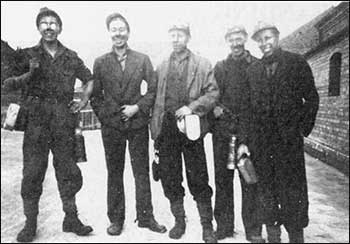 |
|
Some of the Bevin Boys - Dennis Hill 4th from left
|
In 1943 Britain was so short of coal that any young man who was called up for Military Service could instead become a coal miner. Apart from a number of 'conscientious objectors' very few went for this option. It was therefore decided by the Minister of Labour, Ernest Bevin, that one in ten young men would be 'conscripted to the mines' and in total some 48000 young men served their country in this way. They became known as 'The Bevin Boys' and contrary to popular belief they were not conscientious objectors! After many years being denied the right, they now march proudly past the Cenotaph each Remembrance Sunday.
I was born and brought up in Rushden. attended Newton Road School, and on leaving worked as an apprentice painter & decorator. At the age of seventeen and a half I registered for compulsory military service hoping to join the Navy. Three months later I passed my medical 'A1' and was told I would be joining the Army! One month before my 18th birthday I received my 'call up' papers telling me that I had been chosen, by ballot, to work in the coal mines. This came as a big shock to myself and my family as we knew nothing of this side of the war effort. I was told to go to the Labour Exchange where I was issued with a travel permit and told to report to Chesterfield Labour Exchange on 28th August 1944, just three days after my 18th birthday. There were about 30 new 'Bevin Boys' reporting and we were taken to Cresswell Colliery for one month's basic training. We lived in a specially built hostel which consisted of nissen huts each housing 12 miners. At the end of the month we were sent to various collieries and I went to Clipstone, near Mansfield, with 6 others, 2 from Bedford, 1 from Brighton and 3 from London. The living accommodation was the same as at Cresswell. We had to get up at 4.30am to make the 10 minute walk to the bus, and then travel 7 miles to the colliery. Our first week was spent working at the pit top but then we started work underground. The pit shaft was 680 yards straight down and we descended in a very primitive cage which carried 20 at a time. The sensation of descending (very rapidly) was far from pleasant and if I could I always stood in the middle. Approximately 850 men worked at the pit which produced 3000 to 3500 tons of coal each day! My job was on the 'haulage line' getting the empty tubs to the coal face which was some 2 miles away. I never worked the coal face as this job was for regular miners.
During my first year as a 'Bevin Boy' I felt very bitter about not being allowed to join the 'Forces' like my friends, but once this was out of my system I just got on with the job. During my time at Clipstone 4 miners were killed in mining accidents, 2 of whom worked on the haulage line. I was 'demobbed' after four years.
|
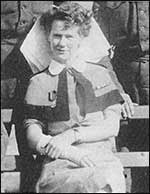 |
|
Sister Sheridan
|
Queen Alexandria's Nursing Service by Sister F. Sheridan P/313220
I joined the Queen Alexandria's Imperial Military Nursing Service Reserves in 1943 and served for 6 years. In July 1944,I went to Normandy with my unit to work in a tented hospital and arrived in time to treat the Caen Allied wounded and German prisoners. The hospital staff were returned to the U.K. in November but in January 1945 were sent to Belgium. After VE Day, the hospital staff were flown from Brussels to Bergen Belsen where I nursed 140 displaced persons, including a Chinese cook whose ship was destroyed in Hamburg harbour. The temporary hospital was in the Wermacht Barracks, whilst nursing personnel lived in tents. I was there for over a month and then transferred to Hanover, leaving the Q.A.s in December 1949 to work in civilian hospitals.
|
D-Day Landing by Jack Tear, PO/X113275
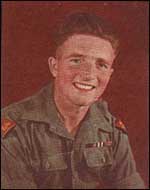 |
|
Jack Tear
|
On D-Day 1944, I was a member of the Royal Marines Armoured Support Regiment, a unit specially formed to give close artillery support to the Commandos and other assault troops as they went up the beaches. We were to go ashore at the same time as them, in waterproofed tanks - apparently in previous landings the only heavy guns to help keep the enemy's heads down were from ships several miles away. Our tanks were chained, two per flat bottomed landing craft. We started firing our guns two miles from the shore, making the beach at 7.30am. Our action was not without casualties, our second tank was hit and one of those killed was Eric Youngman, a special friend of mine, only 23 years of age. After several days of intermittent and heavy fighting the objective was achieved. In time we waited to be posted to a different theatre of war, and as the weeks passed we knew and accepted the fact that we would soon be putting all that we had trained for in action against the Japanese. It was a sobering thought at the back of our minds, accepted philosophically as inevitable and with no expectation that it wouldn't happen. And then suddenly the use of the Atom Bombs on Japan ended the Japanese resistance - and the war in the far East was over. Suddenly the future looked brighter and safer with the knowledge that we would soon be on our way home. I was among the older personnel and therefore among the first to be repatriated. After several postponements and fond farewells to friends we had lived and worked with for several years, we sailed from Bombay and arrived home at the beginning of February 1946.
|
Rushden Memorial Hospital
'You need have no fear regarding the future of this hospital; it is here to do the work that you desire to be done'. With this assurance from the Ministry of Health's representative, the large house which Rushden had purchased as its War Memorial Home Hospital was, on Saturday 29th January 1949, dedicated and handed over as part of the National Health Service.
Relatives of the 138 men, women and children whose names appear on the memorial panel in the vestibule were among the large crowd who attended the opening. Councillor Paragreen, Chairman of the Rushden Urban District Council, spoke of the hospital as a worthy offering by the residents to commemorate those who lost their lives in the Second World War.
|
Evacuated For Safety by Shirley Garfirth nee Ferrell
Our family was evacuated to Rushden in 1940, and we were sent to live with Mrs O'Key in Albion Place. We stayed until the end of the war when some of the family returned home to Kentish Town, London. I stayed in Rushden and married a local boy, Roy Garfirth.
The lady in the photo is Mrs O'Key's daughter Beatrice, and I'm on the left of the photo.
|
Rushden & Higham Ferrers Spitfire Fund
The cheque representing the efforts of Rushden and Higham Ferrers for the purchase of a Spitfire was presented to the Rt. Hon. R.B. Bennett K.C., LL. B. on behalf of the towns by W.C. Tarry Esq. Chairman of the Spitfire Fund, Joint Committee, 12th November 1940.
The name given to this Mk IIb Spitfire (serial no. P8385) was Impregnable, after a trade name used by John White (who, along with his employees, donated £5,000). Delivered from the works on 27th April 1941, it went to 303 Sqn. at Northolt, Middlesex on 12th May. Mainly used in the bomber escort role with a variety of pilots, Pilot Officer Feric shot down a Me 109 on 22nd June, and on the next day Sergeant Szlagowski shot down another Messerschmitt. Impregnable's final victories with 303 Sqn. came on 2nd July with Flying Officer Zumbach at the controls who shot down one Me 109 and damaged another.
Many moves around the country followed, and Impregnable was involved in a number of accidents - though always repaired. Finally Impregnable ended up in a training role for six months, then retired to 45MU, Kinloss, on 11th September 1944 before being struck off charge on 23rd November 1944, and subsequently scrapped.
|
An Army Experience by Joe Ekins
I was born in Yelden, left school at age fourteen, and worked as a clicker in the shoe factory of Knight and Lawrence in Rushden. At age sixteen my family moved to live in Rushden. I joined the LDV, but in the early days they were ineffective so I resigned and volunteered to join a Tank Regiment as soon as I was old enough. I was posted to Bovington. The journey itself was an adventure, as until then apart from a trip to Scotland and a day trip to Yarmouth I had only travelled within cycling distance of Rushden. I was at Bovington for six months training where you lived in fear of dire consequences if you did not, or would not, perform the most menial, unrewarding, and time wasting tasks. Apart from about two months on Gunnery, Radio, and Driving, the time was wasted. After initial training I was posted to the 1st Northamptonshire Yeomanry. For about two years and a series of different types of tank, we moved around the country waiting for something to do. A boring time was relieved by a couple of leaves and ENSA concerts. We also took part in a few exercises which proved later to bear no relation to the real thing. We were supplied with Firefly tanks, at one per troop, a few days before D-Day, and I joined a crew as a Firefly gunner. We arrived in France on D6 and moved into the small bridgehead. We stayed in roughly the same bridgehead for about six weeks, and soon learned that war is not glorious but an awful hell of blood, muck, stench, and death, and that no matter how often you prayed, or to whom you prayed, it made no difference. You could only rely on yourself and a few friends around you who were getting killed day by day.
On the evening of August 7th we lined up in two columns with Northant's Yeomanry leading one column and drove through the night, four miles into enemy territory to a village called Saint Aignon. The following day we fought in what proved to be probably the Yeomanry's greatest battle, and in the German counter attacks we lost 20 tanks including my Firefly. This started the breakout and for the next five or six months we fought our way forward day by day, first through France, then Belgium, and into Holland. We were rushed from Holland to Namur, then onto Marche to support the Americans in the Battle of the Bulge. We then had a pleasant three weeks training in Buffalos, in preparation to transport the infantry over the Rhine into Germany. The river crossing proved to be our last operation of the war. Some months after the end of the war I was seriously ill with Diphtheria and after some weeks in hospital in Germany I came home in an hospital ship.
Footnote by Keith Hill:
On 8th Aug 1944 Joe Ekins 'knocked out' four Tiger tanks of the German Waffen SS. Many years later it was discovered that one of these tanks was that of SS Hauptsturmfuhrer Macheal Wittman who was one of the top German tank aces.
|
|
Protecting The Coastline by Chief Petty Officer B.S.Rollings P/MX.69685
In July 1940 I volunteered for service with Coastal Command, and as a Motor Mechanic was drafted into the Motor Torpedo Boat section, serving on MTB 34, one of thousands being constructed in boatyards all around the country, a wooden, double hulled vessel, light but fast, capable of 40 knots [45mph] and carrying two 21 inch torpedoes, ready for instant action. MTB 34 was powered by three Italian engines which were superior to any subsequent motors. Later posted to MTB 704, on D-Day we were like a sheep dog shepherding a flock, circling round the invasion fleet as it crossed the English Channel, safeguarding troops and supplies during the assault on Normandy. As Chief Motor Mechanic, the maintenance of the engines was my responsibility to keep them in tip top working condition and ready to respond at all times.
|
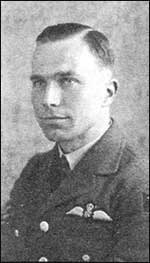 |
|
D H Jeeves
|
Sergeant Pilot Dennis Herbert Jeeves
Reported 'missing as a result of Air Operations on Saturday 19th July 1941'.
An envelope left with his Squadron stated:
Note 'This envelope to be opened & letter inside
posted only in the event of my becoming missing'
D.H.Jeeves Sgt. 758013
|
My Contributions To The War Effort by Flight Lieutenant Geoff Wheeler Flight Commander 33 Squadron RAF
After qualifying as a motor mechanic at Wargate Motors, at the outbreak of war I went to Coventry to work in aircraft production - making the weekly journey by motorbike, leaving at 5.30am to start work at 7am. Very difficult in the dark with masked headlights. I witnessed 87 bombing raids including the 'blitz' of 14th November 1940, a night I will never forget. The raid lasted all night and the city : mass of flames and the noise of the bombs and ack-ack fire was terrifying. in the Homeguard and assisted where possible. The aircraft factory was a ¼ mile square with a machine-gun post at each corner. Despite being hit numerous times, and several workers being killed, the factory always resumed production amazingly quickly after a raid. I finished my 'tour of duty' in Coventry on September 14th 1942 and reported to the Air Crew Receiving Centre in London, subsequently going to Canada to commence my flying; gaining my 'wings' in 1944. Back in England I flew Hawker Tempest V's Fighter Planes, at that time the fastest piston engine planes in the world. By VE Day I was stationed at an airfield in Germany named Quakenbruck, and there sustained my only war nound when a 'celebrating' fellow pilot, somewhat worse for drink, fired off his .38 Smith & Weston revolver, damaging my wardrobe and contents, and injuring me with shrapnel, so to me VE Day appeared more like the beginning of another war!
|
Yanks by Keith Hill
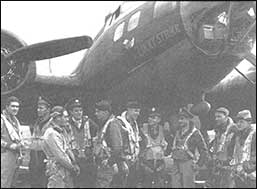 |
|
Some of the 'Yanks'
|
Early on the morning of Sept. 5th 1942 twelve Flying Fortress's of the 301st Bomb Group (Heavy), US 8th Army Air Force took to the sky from Chelveston airfield. Fully loaded with bombs, their mission was to bomb Rouen in Nazi occupied France. Later in the day all twelve aircraft returned. For the people of Rushden and Higham Ferrers who witnessed this event it was one that, over the next two and a half years, would become so familiar.
In November 1942 the 301st E.G. was replaced by the 305th E.G. and in early 1943 the 92nd E.G. moved into Podington, a couple of miles south of Rushden, from Alconbury. Sadly, unlike the Sept 5th mission, subsequent missions would not be without loss and by VE Day the 8th Air Force had lost 25000 men killed or missing in action. During one period losses were so great that each of these young men, all volunteers, knew he had only a one in ten chance of surviving the twenty five missions required of him. Yet day by day, week by week, they went.
These young men were not only thousands of miles from home, they were from a different culture. They had all the confidence of youth ... American youth. They were better dressed and better paid than British servicemen. It is perhaps little wonder that local people soon coined the phrase 'Yanks ... Over paid, over sexed, and over here!' It was though, this same culture, this same up-bringing that made these young airmen fiercely patriotic and cherish the words 'Freedom and Liberty'. To suggest that all of the Americans who joined the armed services and came to England did so simply to 'liberate' Europe would be naive but there is no doubt that without them the liberation of Europe could not have taken place.
Over paid? Maybe. Over sexed? Maybe. Over here? Definitely ... and of all those from Podington and Chelveston who visited Rushden' pubs, churches and shops, 1600 stayed 'over here'. Many have no known grave but many lie in the American Cemetery at Madingley in the peace of the English Countryside.
|
|